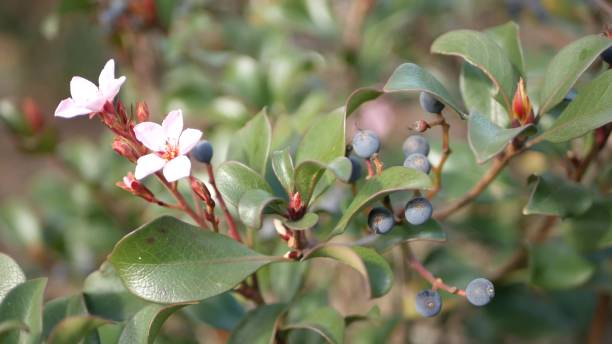What Is Indian Hawthorn?

The Indian Hawthorn, Rhaphiolepis Indica, is an evergreen shrub with a dense habit. It has dark green leaves and glossy red berries that resemble small apples. The plant can grow up to 10 feet tall and features clusters of fragrant white blossoms in late spring or early summer.
Indian Hawthorn Care & Maintenance:
Indian Hawthorn is a flowering shrub with dark green leaves and glossy, red berries. It usually grows about 10 feet tall and features clusters of fragrant white blossoms in late spring or early summer. Indian Hawthorns are hardy plants that can be grown outdoors as well as indoors.
Indian Hawthornes prefer full sun exposure, but they will tolerate partial shade and do well in moist soil that drains quickly.
They also require little maintenance other than pruning to maintain shape and size. The plant requires very little water when established, so it’s a good choice for drought-stricken areas where watering restrictions may apply year-round.
In the event the plant does need more water because of extended drought periods, make sure you increase the frequency of watering, not the amount.
Too much water can cause the roots to rot and kill the plant. When plants are transplanted outdoors, they need extra TLC while adjusting to their new environment.
Watering them twice a day is recommended during transplantation until you’re sure of their survival. Otherwise, water only once weekly if you’re growing Indian Hawthorns indoors.
Avoid letting plants sit in standing water for too long because this prevents proper transpiration from occurring and will also lead to root rot infection.
Where To Buy:

Light Requirements:
Most tropical plants prefer full sun exposure, but Indian Hawthorns are an exception. As a rule of thumb, the lighter they receive the better, but be careful to provide ample airflow at the same time.
If you grow them indoors make sure you place them near a window where they can get indirect sunlight or supplemental fluorescent lighting. This will also ensure proper pollination and fruit production.
Afternoon sunlight is ideal for most plants because it mimics their natural growing environment. When placing your plants outside, make sure that there’s plenty of shade coverage during the hot afternoon hours when temperatures soar above 90 degrees Fahrenheit (32 degrees Celsius).
Understanding Watering Needs:
Getting to know how much water your plant requires helps you avoid overwatering or underwatering your plants, both of which are unhealthy for the plant.
When using a soil moisture meter you can insert the probe several inches into the soil to measure water levels in the root zone. This gives you a good idea of how much water your plant needs because there’s typically more than one source of water available in the area where it is planted.
The outer layer of soil will be dry and hard while deeper down there may be wetter, spongier soil that holds more water. Also, consider rainfall patterns and other sources of water that may affect Indian Hawthornes during different times of year in your area.
Water Requirements:
The water needs of your Indian Hawthorn will depend on climate and other factors such as soil type or whether it’s indoors or outdoors. If you live in a warm, arid region where the temperatures are high during the summer months, your plant may need more water than someone who lives in a cool temperate zone with low humidity.
Indian Hawthorns require less frequent watering when they’re kept indoors because they receive regular moisture from tap water due to overhead misting applications or an automatic watering system.
They must be watered more frequently if you grow them outdoors and don’t have any irrigation systems installed. Some people don’t even bother using an irrigation system but simply water their plants every few days depending on how fast the top layer of soil dries out.
If you live in a very hot area where the temperatures stay above 90 degrees Fahrenheit (32 Celsius) during the day, try to water your plants early in the morning so that they have time to dry off before sunset. This helps prevent plant diseases such as blight from occurring because wet leaves are more susceptible to infection.
Watering Conventions:
There are several different watering schedules for Indian Hawthornes depending on factors like climate or whether they’re indoors or outdoors.
If you’re growing them indoors where there is no natural rainfall and overhead misting systems aren’t used then it’s important to check on them at least weekly during the spring and summer months when temperatures rise above 80 degrees Fahrenheit (26 Celsius).
It’s also a good idea to use a moisture meter on a regular basis and check the soil’s water content.
Soil Requirements:
The soil type you use for Indian Hawthornes will depend on where you live and what’s available. If you’re not sure about the composition of your soil then ask an expert at a local nursery, or perhaps do some research online if that option is more convenient.
If you want to be extra careful just go ahead and mix up your own custom blend using the information below as a guide.
A basic soil recipe might include 2 parts loam, 1 part sand, 1 part peat moss, and 1 part perlite. This mixture supplies good drainage which is important because soggy soil can lead to root rot infection.
Temperature and Humidity Requirements:
Indian Hawthornes do best if you can provide a temperature range between 50 and 75 degrees Fahrenheit (10 to 24 Celsius). They like it cooler than that especially during the winter months when temperatures below freezing become common.
High humidity is also recommended for good growth but be careful not to overdo it because too much moisture in the air will lead to rotting.
If possible try to keep Indian Hawthornes indoors where air conditioning systems or dehumidifiers maintain stable conditions year round.
Fertilizing Requirements:
Fertilize your Indian Hawthorn on a regular basis using a water-soluble, balanced fertilizer with a ratio of 1:1:1. This means that it’s not too rich and not too weak but provides the correct balance of nitrogen (N), phosphorus (P), and potassium (K).
The most common fertilizers used in this type of application are 20-20-20 or 10-10-10. Read labels carefully because some products may have more than one source of nitrogen which might cause problems if overused.
Once established Indian Hawthornes don’t require much fertilizer except during times when new growth is occurring or after they’ve been repotted into larger containers. If you’re growing them in a container then fertilize them on a regular basis with a weak solution to keep them healthy and growing.
In addition to the above information, you may also want to use specialized products designed for flowering plants like Holly Tone or Holly-Tone Plus which provide trace minerals needed for optimal growth. You can find these products online or at local nurseries.
If you’re using peat moss as part of your soil mixture then avoid fertilizing because it already provides nutrients that are released over time instead of all at once.
Pruning Requirements:
Pruning is a fundamental part of the care and maintenance required for Indian Hawthornes. The process can be intimidating but it’s not hard to learn, once you understand what needs to be done. And knowing the right time to trim will help your plants stay healthy and strong so that they produce lots of flowers each year.
Pruning is NOT just about shaping them up at the end of winter or early spring as many people think. It’s also about removing dead woody growth from throughout the plant in order to keep it healthy over time. The best time for this type of pruning is during late fall when temperatures are cooler because branches are less likely to break off due to loss of moisture through evaporation.
So, what exactly is dead woody growth anyway? It’s any branches that are discolored or have bumps where the bark is peeling back away from it. This type of branch can easily snap off and kill your plants so you’ll need to remove them before they become a problem.
The bump near the bottom of this branch indicates that it has died on the inside due to insect damage, disease, or overuse of fertilizer (yes, too much fertilizer can hurt your plants). If left alone this branch will die completely and may break off in a storm or when someone walks by, potentially damaging other nearby branches or even falling on top of people and pets.
This is the right way to remove a dead branch:
Look for a live growing tip on one of the remaining branches then determine where you want your new growth to be positioned and cut that area in half using a sharp pruning blade or shears. Once the branch breaks off, trim away any additional pieces until only 1/2 inch remains at its base.
In order for this branch to grow again, it must have some living tissue on it so make sure you leave at least 1/2 inch at its base when you remove it.
If you’ve gotten rid of all dead woody growth from around this plant (and all others too) then you’ll have to leave more behind because dead woody growth is likely hiding under the soil where you can’t see it. They usually show up again when something dies or is removed from inside a plant.
Once you’ve done your clean-up pruning, make sure you allow any broken branches to heal over before heading into winter.
In addition, fertilize these plants on a regular basis from November through February with a water-soluble fertilizer that has at least 3% nitrogen (N) and 1% phosphorus (P). This type of fertilizer will help ensure healthy new growth next year along with flowers and fruit once summer arrives.
Propagation Requirements:
Indian Hawthornes do not reproduce by seed but grow easily from cuttings that are taken in spring or summer. It’s best to use semi-hardwood stem tip cuttings about 3″ long, strip off the leaves at the bottom, dip them in a rooting hormone and then place inside of potting soil mixture where they’ll get plenty of light, but no direct sun.
Hoya (not Indian Hawthorne) root system Hoya (not Indian Hawthorne) flower
The most common method of propagation is by layering which involves bending a branch so it stays on top of the ground and covering with dirt.
You can also take side shoots that grow off of main stems and root them in pots. This method is less common but it’s great for helping to increase plant numbers or if you want to create new cultivars from your favorite varieties.
Potting and repotting Requirements:
Indian Hawthornes are slow-growing and won’t need repotting for at least two years after you first plant them.
However, if their roots fill the container or become pot bound then they’ll have to be transferred into a larger one (or two) so that they can continue to grow properly. It’s also important to prune back the top growth by 1/2 in order to make room for the new roots which will expand outwards as your plants grow bigger over time.
Repotting should occur every spring once temperatures begin climbing above 50 degrees F but before nighttime temps get too high (60F is ideal).
Indian Hawthorn Pest Problems & Solutions:
Insects:
Mealy Bugs – Butterflies on your plants? They may be mealybugs! These pests can be difficult to control once they’ve become established inside of a container so inspect all of your plants often.
Because they love warm, humid conditions it’s best to take action as soon as you see them appear. If you don’t act quickly then these bugs will begin laying eggs that will eventually hatch into more of the same which means there could easily end up being hundreds of them around in no time at all. They also tend to cluster on the undersides of leaves so keep a close eye (or magnifying glass) on any new growth.
So, how do you control them? Your best bet is to mix up some insecticidal soap and spray it all over your plant. Repeat every 7-10 days for 3-4 applications as needed then use neem oil as a last resort if things get out of hand again next year.
Lacebugs – Lace bugs are very similar in appearance to mealybugs but they’re not nearly as destructive or common inside of homes/gardens.
They produce white powdery wax secretions and like to feast on the ‘net’ of the leaves. If you have them, use insecticidal soap or neem oil to get rid of them as needed.
Scale – Scale insects are most commonly found on stems and branches which can impact a plant’s ability to transport water efficiently.
This makes them especially troublesome for plants that are grown inside where you may not notice any signs until it’s too late and the plant has already begun suffering from stress/dehydration (which is often misdiagnosed as overwatering). If left untreated this cycle will continue indefinitely so remember, when in doubt… toss it out!
To remove these bugs scrape off any with a plastic card then spray the affected area with insecticidal soap, neem oil, or horticultural oil to kill the rest.










